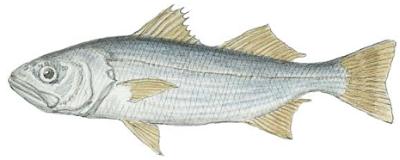The queenfish is a small croaker and a member of the Sciaenidae family (drum and croaker). Essentially a panfish-size bottom scrounger, it is not an esteemed sport or food fish, but it is commonly caught from Pacific coast piers and may be desirable as whole or cut bait for other species.
Identification
The queenfish has an elongated, moderately compressed body. The upper profile is depressed over the eyes, and it has a large mouth. Its coloring is bluish above and becomes silvery below. The fins are yellowish. This species is distinguished from other croaker by its large mouth; by the base of its second dorsal and anal fins, which are roughly equal; and by the wide space between its two dorsal fins. There is no chin barbel on the lower jaw.
Size
The maximum length of the queenfish is 12 inches, but most fish are considerably smaller.
Spawning behavior
Spawning occurs along the coast in the summer. The eggs are free floating, and newly hatched juveniles appear in the late summer and the fall; they gradually move shoreward from depths of 20 to 30 feet into the surf zone.
Food
Queenfish feed on small, free-swimming crustaceans, crabs, and fish.
Other Names
herring, herring croaker, kingfish, shiner, queen croaker; Spanish: corvina reina.
 |
| Queenfish (Croaker) |
Distribution
The queenfish is found along the Pacific coast, from Yaquina Bay, Oregon, to Uncle Sam Bank in Baja California, Mexico. It is common in Southern California but rare north of Monterey.
Habitat
Queenfish commonly inhabit shallow water over sandy bottoms in the summer. They mostly occur in water from 4 to 25 feet deep but have been known to dwell as deep as 180 feet. They often gather in tightly packed schools, sometimes with white croaker, in shallow sandy areas near pilings and piers, and they migrate to deeper water at night.



